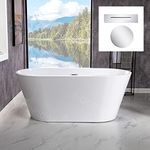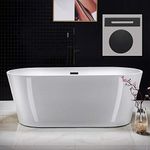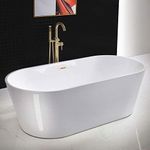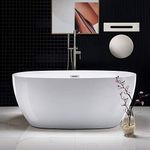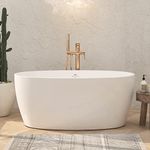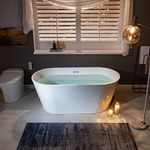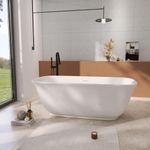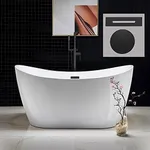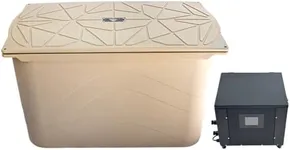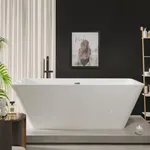Buying Guide for the Best Freestanding Soaking Tubs
Choosing the right freestanding soaking tub can greatly enhance your bathing experience and add a touch of luxury to your bathroom. When selecting a tub, it's important to consider various factors to ensure it meets your needs and fits well within your space. Here are some key specifications to help guide you in making the best choice.MaterialThe material of a freestanding soaking tub affects its durability, weight, and heat retention. Common materials include acrylic, cast iron, and stone resin. Acrylic tubs are lightweight, easy to install, and retain heat well, making them a popular choice for many. Cast iron tubs are heavier and more durable, offering excellent heat retention but requiring a stronger floor to support their weight. Stone resin tubs are luxurious and retain heat well, but they can be quite heavy and expensive. Choose a material that balances your need for durability, heat retention, and ease of installation.
Size and DimensionsThe size and dimensions of the tub are crucial for ensuring it fits comfortably in your bathroom and provides a relaxing soak. Tubs come in various lengths, widths, and depths. A standard length is around 60 inches, but you can find tubs ranging from 55 to 72 inches or more. The width typically ranges from 27 to 32 inches, and the depth can vary from 14 to 20 inches or more. Consider the available space in your bathroom and your personal preference for soaking depth when choosing the size. Ensure there is enough room for installation and movement around the tub.
CapacityThe water capacity of a freestanding soaking tub determines how much water it can hold, which affects the soaking experience. Tubs with larger capacities allow for deeper and more immersive soaks. Capacity is usually measured in gallons, with smaller tubs holding around 40-50 gallons and larger tubs holding 60-80 gallons or more. Consider your preference for water depth and the capacity of your water heater when choosing a tub. A larger capacity tub may require a more powerful water heater to fill it adequately.
Shape and DesignFreestanding soaking tubs come in various shapes and designs, including oval, rectangular, and slipper styles. The shape and design can impact both the aesthetic appeal and comfort of the tub. Oval and rectangular tubs offer a classic look and are generally more spacious, while slipper tubs have a higher backrest for added comfort and support. Choose a shape and design that complements your bathroom decor and provides the level of comfort you desire. Consider how the tub's design will fit with the overall style of your bathroom.
Drain PlacementThe placement of the drain in a freestanding soaking tub can affect the installation process and the comfort of your soak. Drains can be located at the center, end, or side of the tub. Center drains are common in symmetrical tubs and provide balanced water drainage, while end drains are typical in slipper tubs and can be more comfortable for reclining. Side drains are less common but can be found in some unique designs. Consider the plumbing layout of your bathroom and your preferred soaking position when choosing the drain placement.
WeightThe weight of a freestanding soaking tub is an important consideration, especially if you are installing it on an upper floor. Heavier tubs, such as those made from cast iron or stone resin, may require additional floor support and can be more challenging to install. Lighter tubs, like those made from acrylic, are easier to handle and install but may not offer the same level of durability. Consider the structural capacity of your bathroom floor and the ease of installation when choosing the weight of your tub.
